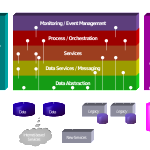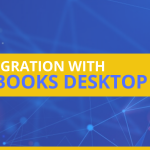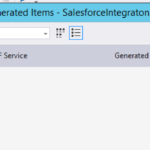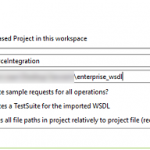[New Post] 7 Major Challenges in adopting IoT for Retail Companies
In September 2014, Forrester Research conducted an online survey of 593 organizations in 16 countries. Respondents were IT decision-makers responsible for IoT initiatives in their respective companies. Following are the main challenges that respondents identified from a technical implementation perspective. In this post, we explore, what these challenges mean for a retailer.
1. INFRASTRUCTURE & NETWORKING ELEMENTS
For a retailer, the three most important areas in which IoT can deliver business value are logistics, inventory management, and in-store operations. Consider the instance of only one function which is in-store management.
IoT proliferation in retail stores will result in a large number of sensors and digital tags in a typical retail environment. For instance, video cameras, motion sensors, door hinges sensors, shelf weight, tags, and digital signage are just a few examples of the expanding sensing layer that IoT’s networking elements will have to take care of. Networking elements of IoT should ensure data transfer and wired and wireless networks. Things within an IoT ecosystem have to perform pre-assigned tasks collaboratively.
Action Item
Service providers should design their network management technology in a way t it is capable of communicating with wired, wire, and mobile networks.
Download Your Free IoT Practice Development Guide Here
2. SECURITY SOLUTIONS
Securing a bundle of devices that operate over heterogeneous networks is a major challenge in the retail space. The need to secure device data and enterprise communication will increase as a result of heightened data collection. The need for security rises in case camera-equipped devices are used in an IoT ecosystem.
Action Item
Service providers such as system & device integrators as well as consultants should guide their clients to prefer IoT devices that are designed as security devices rather than security being added as an afterthought. In regards, FTC (Federal Trade Commission) published an actionable checklist for IoT companies that they can use to enhance nce security of their IoT devices and networks.
3. DATA ANALYTICS
Data analytics is an important layer in implementing an IoT solution. Retailers need 24/7 support from service providers to help build the visualization engines, build and deploy data analysis tools, enhance machine learning, and acquire AI (Artificial Intelligence) capability. Collecting data from smart devices and self-aware sensors, aggregating, and warehousing the same,data, and securely transfers it to the visualization engine also requires significant expertise. Thus, achieving the same becomes an important challenge in a retail environment.
Action Item
For designing a data analytics layer in an IoT solution, the end goal should be to deliver data with a rich context having pattern recognition and predictive analysis capacity.
4. SENSORS & DEVICES
Selecting an appropriate stack of sensors (motion, temperature, pressure, etc.), devices, RFID, tags, and actuators demands the hat context of use is clearly defined and understood by the technical resource. A competent IT function has to exist for managing these devices effectively.
Action Item
It is important that the sensor/tag requirements for a retail environment (each retail setting has different goals for which IoT solution is adopted at a given point in time) are assessed at the onset of the project.
5. VALUE CHAIN COLLABORATION
The value chain for an end-to-end IoT solution is vast and requires the expertise and collaboration of multiple companies within an IoT ecosystem. To make the best use of an IoT solution, retailers will need to ensure unprecedented collaboration, connectivity, and coordination for each IoT element individually as well as an integrated information system.
Action Item
To deliver a high ROI to the retailer for an IoT solution, make smart choices (with regards to selecting appropriate platform forms & service providers). Make sure stakeholders within the IoT ecosystem understands the business value to be derived from the solution.
6. DASHBOARDS & MONITORING CONSOLES
After the implementation of the aforementioned layers of an IoT solution, retailers do not want to miss out on the visualization and analysis of data gathered through the IoT infrastructure. It is important for a business to users have access to visually appealing dashboards that show the positioning and health of inventories, stock, fleet, and customer insights. Bringing data above the waterline requires meticulous work on part of the development team. This can be achieved by teaming up with a seasoned development and deployment team.
Action Item
When designing an IoT solution, monitoring consoles should deliver updates, events, and alerts to users making it easier for them to sift between urgent and important events.
7. CONSULTING SERVICES
This is a crucial challenge for retailers to select the right IT partner for any IoT initiative. The consulting partner needs to be vast experience (across the depth & breadth) in delivering enterprise-level projects.
Action Item
Make sure the IT partner you chose should be well-verinwith Integration (devices & applications), BI (Business Intelligence), and front-end development at an enterprise level and across several verticals.
Key Take-Away
The aforementioned challenges may seem daunting for retailers as well as service providers. However, as mentioned in an earlier post, IoT solutions can be implemented using a more nimble and iterative strategy. Here are the three action points of such an implementation strategy that we recommended:
Look for narrow slices of demonstrable value
Use Existing IT Assets wherever possible
Which challenge was the most daunting for you when implementing an IoT solution in a retail environment?
Resources & further readings
- Internet-Of-Things Solution Deployment Gains Momentum Among Firms Globally by Forrester Research
- Transform the Retail Store with the Internet of Things by Microsoft
- Cisco sRetailers’lers Internet of Things for Analytics by DataInformed.com
- Home Security 2015: The Internet Of Things (IoT) Brings Innovation and Danger published by Fobes
- Principle Elements and Framework of Internet of Things by Bhagyashri Katole, Manikanta Sivapala, Suresh V.








